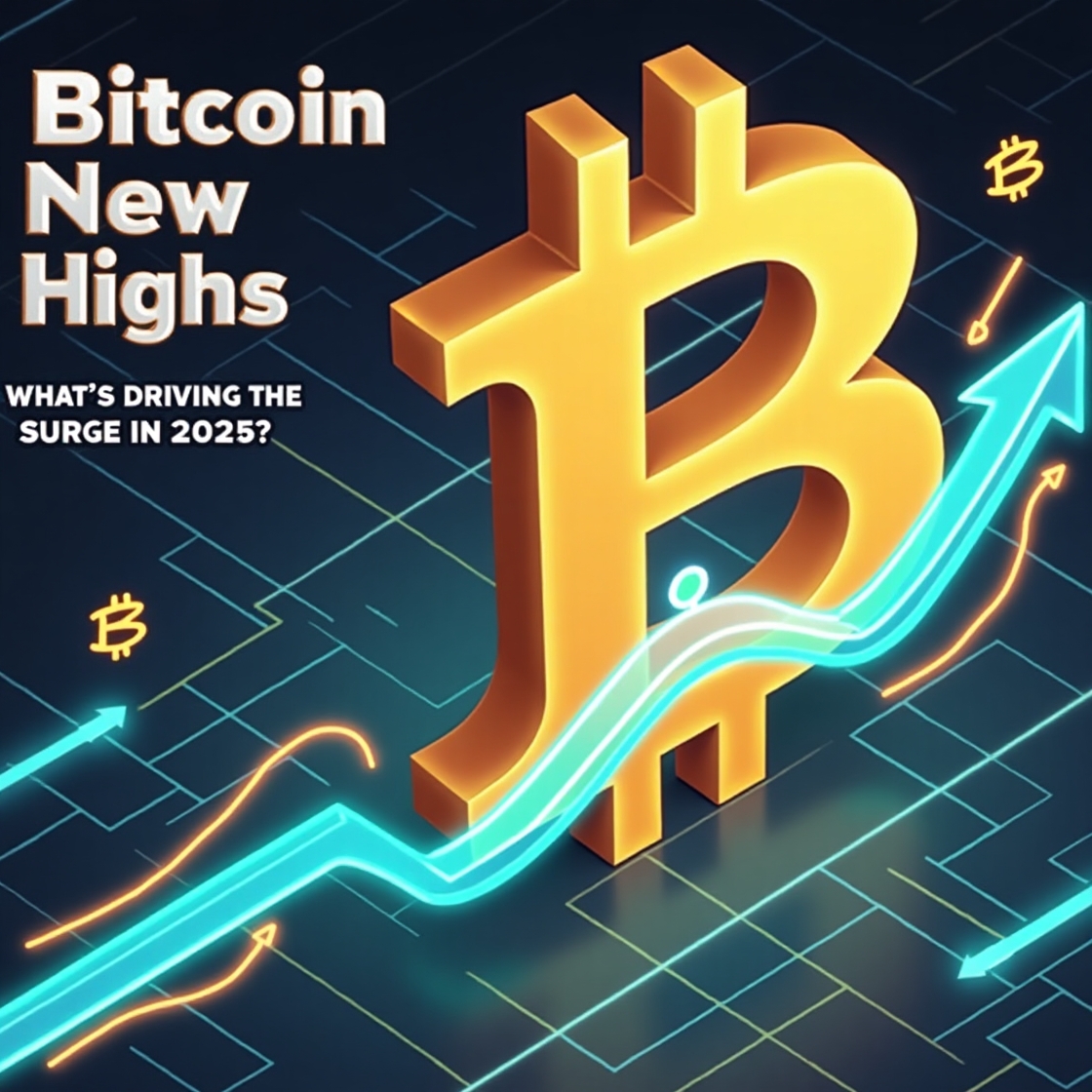“Bitcoin Hits New Highs: What’s Driving the Surge in 2025?
Bitcoin Hits New Highs: What’s Driving the Surge in 2025?
In the ever-evolving landscape of cryptocurrencies, few events garner as much attention as Bitcoin’s price surge, especially when it hits new all-time highs. In 2025, Bitcoin’s price is skyrocketing once again, breaking through previous resistance levels and leaving many investors and analysts asking: what is behind this meteoric rise? While cryptocurrency markets are notoriously volatile, a combination of factors seems to be propelling Bitcoin to unprecedented heights.
1. Institutional Adoption and Mainstream Integration
One of the most significant catalysts for Bitcoin’s price surge in 2025 is the continued institutional adoption of cryptocurrency. Large institutional players, such as hedge funds, asset management firms, and even publicly traded companies, are increasingly turning to Bitcoin as a store of value and an investment asset.
In 2025, Bitcoin has become more integrated into the financial ecosystem. Companies like PayPal, Square, and Tesla, which have previously shown an interest in Bitcoin, continue to lead the charge in making cryptocurrency more accessible to the average consumer. The increasing number of Bitcoin ETFs (Exchange-Traded Funds) and financial products backed by Bitcoin has also made it easier for institutional investors to gain exposure to the cryptocurrency without directly buying and holding it. These factors have significantly boosted investor confidence, contributing to the upward price movement.
In addition, financial regulators in several countries have begun to show more favorable stances toward Bitcoin. After years of uncertainty regarding regulations, some governments are providing clearer guidelines that make it easier for institutional investors to enter the market with greater legal certainty. This has added legitimacy to Bitcoin in the eyes of larger financial players, propelling its value upwards.
2. Geopolitical and Economic Uncertainty
Bitcoin has long been seen as a hedge against inflation and economic uncertainty, and the global economic situation in 2025 is no exception. The world continues to grapple with inflationary pressures, particularly in countries with weakened currencies or those experiencing economic instability. In regions like Latin America, where hyperinflation has plagued countries such as Venezuela and Argentina, Bitcoin offers a more stable store of value compared to local fiat currencies.
At the same time, the global political climate remains volatile, with trade wars, tensions between superpowers, and financial crises affecting traditional markets. Bitcoin’s decentralized nature, free from the control of any central authority, makes it an attractive asset for those seeking financial autonomy in times of crisis.
The 2025 surge can be attributed in part to the increasing recognition of Bitcoin as a “safe haven” asset during times of economic instability. As central banks around the world continue to print money to ease economic pressures, Bitcoin’s finite supply of 21 million coins makes it an appealing alternative for those worried about the devaluation of traditional currencies.
3. Halving Cycle and Supply Reduction
Bitcoin operates on a fixed supply schedule governed by its protocol, with only 21 million coins ever to be mined. This scarcity, coupled with the periodic “halving” events, has been a driving force behind Bitcoin’s price growth over the years. In 2024, Bitcoin experienced its third halving, where the block reward given to miners was reduced by half. This event significantly reduces the rate at which new Bitcoins are created and introduced to the market, which historically has had a direct impact on the price.
The 2024 halving reduced the reward for mining a block of Bitcoin from 6.25 BTC to 3.125 BTC. As a result, the supply of new Bitcoins entering circulation is more constrained, while demand continues to increase. Economic theory suggests that when the supply of an asset is limited and demand rises, the price will inevitably increase. This supply-demand dynamic has been a crucial factor in Bitcoin’s rally to new heights in 2025.
Moreover, with Bitcoin’s increasing popularity, more people are holding their coins rather than selling them. This “HODLing” behavior reduces the circulating supply and further pressures prices upward. Combined with the reduced miner reward, these factors create a perfect storm for price appreciation.
4. Technological Advancements and Network Upgrades
Bitcoin’s underlying technology continues to evolve, improving its scalability, security, and usability. The Lightning Network, a second-layer solution built on top of Bitcoin, is helping to reduce transaction fees and processing times, making Bitcoin more practical for everyday use. This has led to increased adoption in payment systems and peer-to-peer transactions.
Additionally, the ongoing development of Bitcoin’s privacy features, such as Schnorr signatures and Taproot, has enhanced the network’s ability to protect users’ privacy while improving overall efficiency. These upgrades have made Bitcoin more appealing not only as a store of value but also as a currency for everyday transactions, supporting its price growth.
5. Global Shift Toward Digital Assets and Central Bank Digital Currencies (CBDCs)
As the global financial system increasingly shifts toward digital assets, Bitcoin is benefiting from this broader trend. Central banks around the world are exploring or launching their own digital currencies (CBDCs), which has brought attention to the potential of cryptocurrencies in the mainstream financial world. While CBDCs are centralized and controlled by governments, Bitcoin remains the leader of the decentralized cryptocurrency space, offering an alternative to government-issued digital currencies.
In 2025, the rise of CBDCs has highlighted the demand for decentralized alternatives like Bitcoin. People are becoming more aware of the potential risks of centralized financial systems, including surveillance, control, and inflation. Bitcoin’s decentralized nature and fixed supply make it an attractive alternative to CBDCs and fiat currencies that are subject to government manipulation.
Moreover, the continued development of blockchain technology and its application to various sectors—from finance to supply chain management—has bolstered the case for Bitcoin as an asset class. The widespread recognition of blockchain’s potential has led to greater institutional and governmental interest in Bitcoin, further driving its price to new highs.
6. Retail and Retailer Adoption
The adoption of Bitcoin by both small businesses and large corporations as a payment method has significantly contributed to the price surge in 2025. More and more retailers are accepting Bitcoin as a form of payment, driven by the growing acceptance of cryptocurrency and the desire to tap into the digital economy. Major brands such as Starbucks, Microsoft, and even some national governments are integrating Bitcoin payment solutions into their systems.
The increase in the number of Bitcoin users and the ease of spending Bitcoin has helped create a positive feedback loop where more users adopt the cryptocurrency, further increasing its value and utility. As more retailers adopt Bitcoin and more people become familiar with how to use it for everyday purchases, demand for the cryptocurrency rises, leading to higher prices.
7. Global Awareness and Investor Sentiment
Bitcoin’s increasing mainstream awareness cannot be overlooked. In 2025, global media outlets, financial news, and social media platforms are buzzing with discussions about Bitcoin. As more people become familiar with Bitcoin and its potential as an investment, the retail investor sector has experienced explosive growth. Social platforms like Twitter, Reddit, and YouTube continue to serve as hotbeds for cryptocurrency discussions, driving both curiosity and action in the general population.
Bitcoin’s association with major global economic trends and its positioning as a technological innovation in the world of finance have piqued the interest of investors worldwide. This has led to increased participation by both individual and institutional investors, further pushing Bitcoin’s value upward.




Post Comment